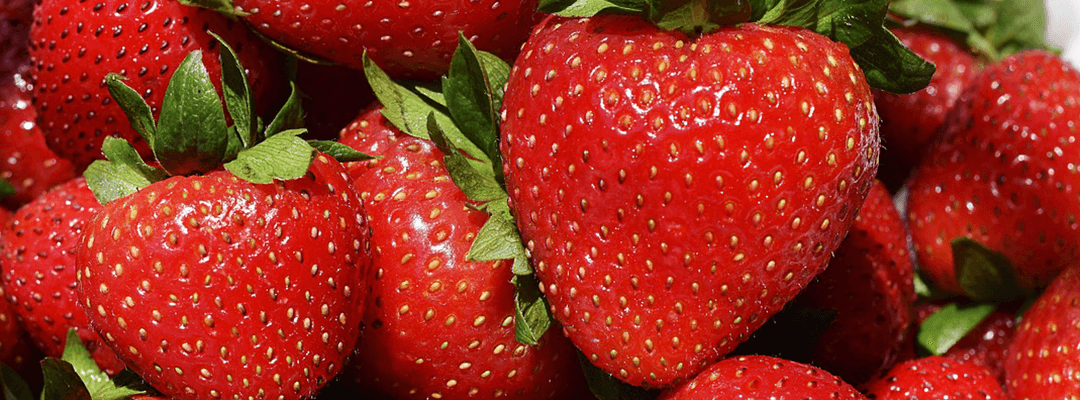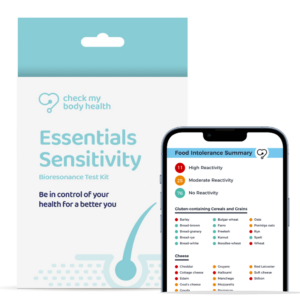
Medically reviewed by Sian Baker, Dip ION mBANT mCNHC
on August 24, 2023. To give you technically accurate, evidence-based information, content published on the Check My Body Health blog is reviewed by credentialed professionals with expertise in medical and bioscience fields.
Signs & Symptoms of a Strawberry Intolerance or Allergy
Enjoying strawberries your whole life, then suddenly bloating or itchy skin after eating them? Intolerances, unlike lifelong allergies, can strike at any time. If you’ve recently started having problems with strawberries, it’s important to understand why this might be happening and what to do about it.
A strawberry allergy or intolerance is a reaction by your body whenever you eat strawberries or foods that contain strawberries. The symptoms range from mild stomach issues through to serious effects such as difficulty breathing. You may also have a similar reaction when you eat foods within the rosaceae family or food that contains the bet v1 protein.
In this post, we’ll explore everything you need to know about strawberry intolerances and allergies, including the symptoms, what other foods you should be aware of, and how to find out whether or not you have one.
What are the symptoms of a strawberry allergy?
Strawberries are a member of the rosaceae, or rose, family of foods, which means if you eat foods from this family and have an allergy, you may experience one or more of the following symptoms:
- Coughing and sneezing
- Wheezing, shortness of breath or trouble breathing
- Nausea, vomiting or diarrhoea
- Hives, itchy skin or a rash
- Pain or cramps in the stomach or gut
- Pale skin
- Feeling dizzy or lightheaded
If you suffer a severe allergic reaction to strawberries, you may experience anaphylaxis, however, this is rare.
What are the symptoms of a strawberry intolerance?
If you have an intolerance, the symptoms are similar to that of an allergy, but usually not as severe. Strawberry intolerance symptoms include:
- Stomach cramps or pain
- Bloating
- Inflammation or swelling of the face or lips
- Constipation
- Diarrhoea
- Headache
- Skin rash or flushing
What is food intolerance?
A food intolerance can develop at any point in a person’s life and is caused by the body finding it difficult to metabolise or process a specific food compound. So, you’re only likely to experience the symptoms of an intolerance if you eat that specific food. This is unlike an allergy, which is often more severe, and you can experience symptoms simply by being exposed to allergens.
Intolerances can still be painful and unpleasant, and if you suspect you have an intolerance it’s still important that you’re diagnosed – that way you’ll know the best way to manage it.
How common is a strawberry intolerance?
Strawberry intolerances are relatively common – it’s estimated that around 10% of people suffer unpleasant symptoms after eating strawberries and other rose and bet v1 foods. Even if you’ve never experienced symptoms in the past, you can develop a sudden food intolerance at any stage of your life.
If you do have an allergy or intolerance to strawberries, then you may also experience symptoms if you eat foods from the rose and/or bet v1 protein families, such as apples, peaches, celery and bananas.
Understanding Cross-Reactivity: Beyond Strawberries
If you have a strawberry allergy or intolerance, you may also experience reactions to other foods due to shared proteins or family relationships. This is called cross-reactivity. Be mindful of these potential triggers:
| Food Category | Examples | Potential Reaction Risk |
|---|---|---|
| Rosaceae Family (related to strawberries) | Apples, pears, peaches, cherries, plums, apricots, raspberries, blackberries, almonds | Moderate to High |
| Bet v1 Protein-Containing Foods | Celery, carrots, bananas, kiwi, melon, soybeans, peanuts, hazelnuts | Varies, can be mild to severe |
Important Notes:
- Individual Reactions: The severity of cross-reactions varies from person to person. You might not react to all the foods listed here.
- Latex Connection: Those with a strawberry allergy may sometimes also be sensitive to latex.
- Seek Medical Advice: Consulting a doctor or allergist is crucial for a personalised diagnosis and management plan.
How do you test for a strawberry allergy or intolerance?
If you experience symptoms after eating strawberries, there are ways to find out whether you have an allergy or intolerance:
- Try an elimination diet, which involves removing rose family and bet v1 foods to see whether the symptoms stop.
- Write a detailed food diary to track the food you eat and whether it coincides with any symptoms.
- Take a food intolerance test to quickly and accurately find out for certain whether you have an allergy or intolerance to strawberries.
- Talk to your doctor, who can offer you advice and the necessary steps for dealing with an allergy or intolerance.
What should you do if you think you have a strawberry allergy or intolerance?
If you’re experiencing symptoms of a strawberry intolerance or allergy, you should stop eating strawberries, foods that contain strawberries, and any foods in the rose or bet v1 protein family until you’re able to get a diagnosis. Allergies can worsen over time, so it’s important not to self-diagnose.
If you’ve started experiencing allergy or intolerance symptoms, take an advanced food intolerance test to quickly find out the cause or speak to a healthcare professional.
What foods should you avoid if you have a strawberry allergy or intolerance?
If you suspect you have a strawberry allergy or intolerance, you should avoid foods that contain strawberries, such as cakes, sweets, desserts, jams and yoghurts.
As strawberries are a part of the rosaceae family, you’ll also want to avoid foods within that family, such as:
- Apples
- Pears
- Blackberries
- Cherries
- Peaches
- Raspberries
- Almonds
- Apricots
- Plums
- Sloes
- Rose buds
Because strawberries contain bet v1 protein, you may also find that you have an allergy intolerance to other foods that contain bet v1. This includes:
- Hazelnuts
- Kiwi
- Celery
- Carrots
- Soybean
- Peanuts
- Melon
- Bananas
- Chestnuts
You may also have an allergy to latex rubber.
10 alternatives to strawberries
If you’re allergic to strawberries and other members of the rose family, but you don’t have an allergy or intolerance to food containing bet v1, you should be fine to eat the following fruits:
- Oranges
- Grapefruit
- Lime
- Bananas
- Grapes
- Mango
- Pineapple
- Lemon
- Melon
- Watermelon
How to test if you have a strawberry allergy or intolerance
It can be difficult to understand whether or not you have an allergy or intolerance to strawberries, including other members of the rose family or the bet v1 protein.
The fastest and most accurate way to find out which foods you’re allergic or intolerant to is with a food allergy blood test or advanced food intolerance test. Order one today to find out in just five working days and take control of your health.
References
1. Vitamin D. NIH, Office of Dietary Supplements. URL. Accessed February 15, 2021.
2. Nair R, Maseeh A. Vitamin D: The “sunshine” vitamin. J Pharmacol Pharmacother. 2012;3(2):118-126.
3. Vitamin D2 vs. D3: Which Should I Take for Bone Health?. Cleveland Clinic. URL. Accessed February 15, 2021.
4. Jetty V, Glueck CJ, Wang P, et al. Safety of 50,000-100,000 Units of Vitamin D3/Week in Vitamin D-Deficient, Hypercholesterolemic Patients with Reversible Statin Intolerance. N Am J Med Sci. 2016;8(3):156-162.
5. On call: Vitamin D2 or D3? Harvard Medical School. URL. Accessed February 15, 2021




